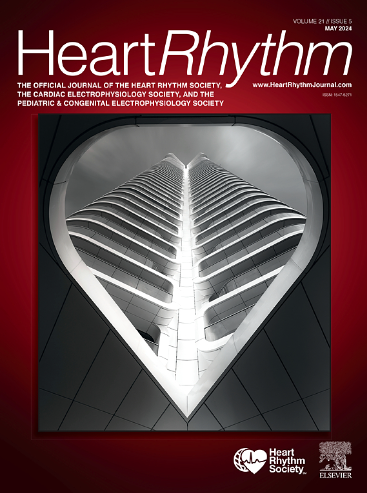通用监测系统("第三方")对 ICD 患者疗效的影响:一项全国性研究。
IF 5.7
2区 医学
Q1 CARDIAC & CARDIOVASCULAR SYSTEMS
引用次数: 0
摘要
背景:对 ICD 患者进行远程监测(RM)时,建议的随访时间表的遵守情况并不一致,这可能会影响临床结果。通过 "第三方 "通用监护系统(UMS)进行系统化组织可能会有所裨益:评估 RM 的临床影响以及 UMS 与传统 RM 相比的增量效益:在法国全国综合健康数据库(SNDS)中,我们确定了 69,394 名有临床数据的 ICD 患者(67.9±13.4 岁,77.5% 为男性,34.9% 为 CRT-D)。我们对患者一年(2019 年)的住院情况和存活率进行了评估。患者按RM状态(No-RM和RM)分类,然后按随访方法(常规制造商特异性RM或UMS)进一步区分RM。调整后的年死亡率和住院率(全因、心力衰竭、次数和持续时间)在No-RM与RM之间进行比较,然后在Conventional RM与UMS之间进行比较:结果:RM 与 No-RM 相比,死亡率有所降低(HR 0.96,95% CI 0.95-0.97,PC 结论:RM 与改善 I 型糖尿病患者的生存率相关:RM与ICD受术者生存率的提高有关。重要的是,我们发现使用 UMS 与临床结果(包括存活率和住院率)的额外改善有关。这些观察结果表明,传统管理的 RM 在组织方面存在挑战,而通用监测平台可以减轻这些挑战。本文章由计算机程序翻译,如有差异,请以英文原文为准。
Impact of a universal monitoring system (“third party”) on outcomes of ICD patients: A nationwide study
Background
Adherence to recommended follow-up schedules for remote monitoring (RM) of patients with implantable cardioverter-defibrillators (ICDs) is inconsistent, which may influence clinical outcomes. Systematic organization through a “third-party” universal monitoring system (UMS) may be beneficial.
Objective
We aimed to evaluate the clinical impact of RM and any incremental benefit of UMS vs conventional RM.
Methods
In the comprehensive French nationwide health database, we identified 69,394 ICD patients (67.9 ± 13.4 years; male, 77.5%; 34.9% defibrillator with cardiac resynchronization therapy) with clinical data. Hospitalizations and survival were assessed for 1 year (2019). Patients were classified by RM status (no-RM and RM), then RM separated further by follow-up method (conventional manufacturer-specific RM or UMS). Adjusted annual mortality rates and hospitalizations (all-cause, heart failure, number, and duration) were compared in no-RM vs RM, then conventional RM vs UMS.
Results
Mortality rate was reduced in RM vs no-RM (hazard ratio [HR], 0.96; 95% confidence interval [CI], 0.95–0.97; P < .001). In RM, all-cause hospitalizations increased in number but their cumulative duration diminished (HR, 0.98; 95% CI, 0.98–0.99; P < .001). Compared with conventional RM, UMS was associated with reduced rates of mortality (HR, 0.74; 95% CI, 0.73–0.77; P < .001), all-cause and heart failure hospitalizations (HR, 0.96; 95% CI, 0.95–0.97; P < .001), and hospital stay duration (HR, 0.96; 95% CI, 0.95–0.97; P < .001).
Conclusion
RM was associated with improved survival in ICD recipients. Importantly, we found that use of UMS was associated with additional improvement in clinical outcomes, including survival and hospitalizations. These observations point to organizational challenges in conventionally managed RM that can be mitigated by a universal monitoring platform.
求助全文
通过发布文献求助,成功后即可免费获取论文全文。
去求助
来源期刊

Heart rhythm
医学-心血管系统
CiteScore
10.50
自引率
5.50%
发文量
1465
审稿时长
24 days
期刊介绍:
HeartRhythm, the official Journal of the Heart Rhythm Society and the Cardiac Electrophysiology Society, is a unique journal for fundamental discovery and clinical applicability.
HeartRhythm integrates the entire cardiac electrophysiology (EP) community from basic and clinical academic researchers, private practitioners, engineers, allied professionals, industry, and trainees, all of whom are vital and interdependent members of our EP community.
The Heart Rhythm Society is the international leader in science, education, and advocacy for cardiac arrhythmia professionals and patients, and the primary information resource on heart rhythm disorders. Its mission is to improve the care of patients by promoting research, education, and optimal health care policies and standards.
 求助内容:
求助内容: 应助结果提醒方式:
应助结果提醒方式:


